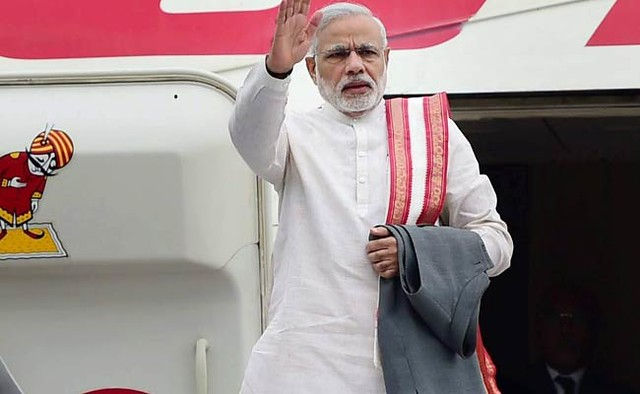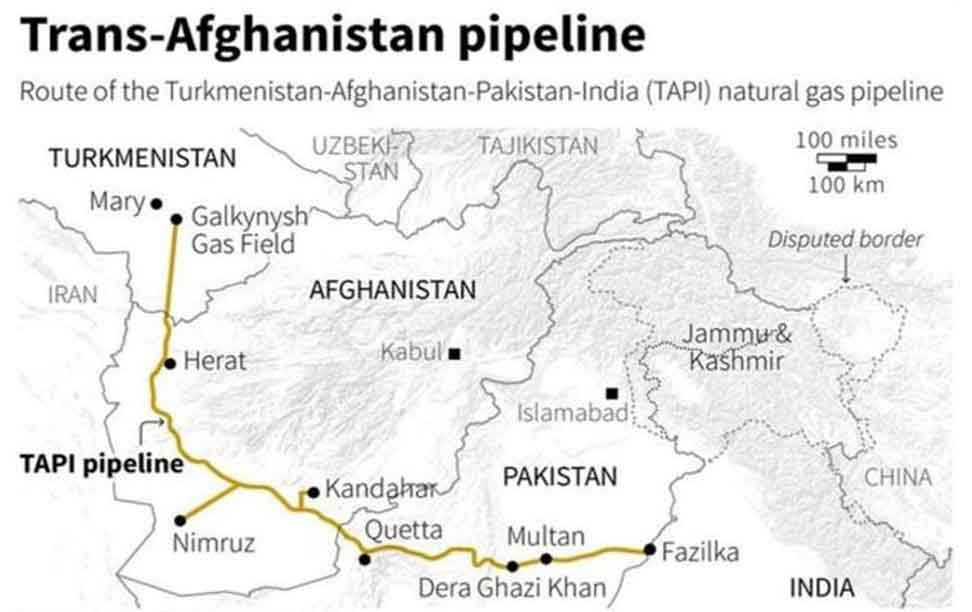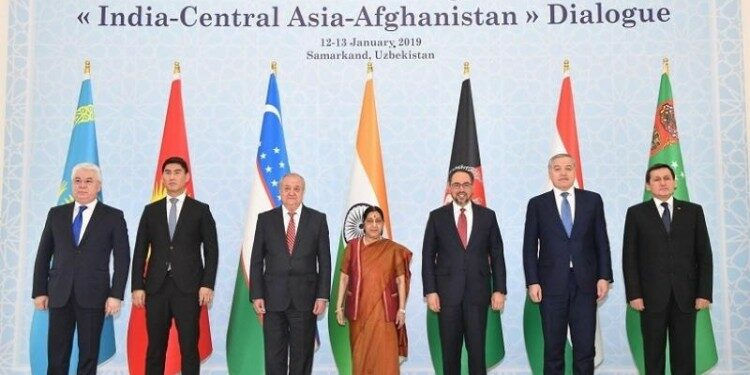Central Asia has recently come under scrutiny again due to the changes it is undergoing and the entry of new players. However, India is a player that is quietly gaining greater regional influence.

Last month of July 2021, India's External Affairs Minister S. Jaishankar completed an official visit to the nations of Central Asia. Eyes were once again fixed on this region following the return to power of the Taliban regime in Afghanistan.
This event sparked intense discussions on the decline of the US and the European Union and the rise of China and Russia. Another actor of which little is mentioned is New Delhi. The US kept India out of most of the political negotiations on Afghanistan, due to pressure from Pakistan. Washington's withdrawal from Kabul has allowed China and Pakistan to gain weight in Central Asia. Therefore, this region will gain importance for India to minimize the influence of its main enemies.
India's ties with Central Asia go back to the ancient Silk Road. Not only did Central Asian cities such as Ferghana, Samarkand and Bukhara play an important role on the Silk Road connecting India with China and Europe, but Indian traders established in the region were an integral part of the local economies. Alongside this, cultural ties would flourish, such as the spread of Buddhism from India to Central Asia and beyond, and Sufism from Central Asia to India. However, from the 19th century until the late 1980s, the importance of this region to New Delhi was almost non-existent.
Before the end of the Soviet Union, India established its only consulate in Central Asia in Tashkent in 1987. However, New Delhi had to adapt to a major economic reform and a new geopolitical chessboard. Thus, former Indian Prime Minister P.V. Narasimha Rao visited four of the five republics: Uzbekistan and Kazakhstan in 1993, followed by Turkmenistan and Kyrgyzstan in 1995. During Tajikistan's civil war between 1992 and 1997, New Delhi would play a key role in limiting Pakistan's influence.
However, during this period cooperation between India and the Central Asian states would be reduced due to the insurgency in Jammu and Kashmir. Also, New Delhi strove not to irritate Russia by focusing on Central Asia and in this first phase, India centered its relations on the 1994 Moscow Declaration.
During the first decade of the 21st century, India maintained slow progress not only because of security concerns, political differences within Central Asia, but also the growing rivalry between the Islamic Republic of Iran and the United States.
However, an annual report by the Indian Ministry of Defence stressed that Central Asia is an area of vital importance for India. Likewise, the former Prime Minister, Manmohan Singh in October 2006, during the Combined Commanders Conference stressed:
"When we look at our extended neighborhood we cannot help but be struck by the fact that India is the only open pluralistic democratic society and the only rapidly modernizing market economy between the Mediterranean and the Pacific [...]. Today, whether it is West Asia, the Gulf, Central Asia or the Indian Ocean region, there is a growing demand for our political, economic and defense engagement."
The turning point came in 2012. Former Indian Minister of State for Foreign Affairs E. Ahmed unveiled the "Central Asia Connecting Policy" in 2012 in Bishkek (Kyrgyzstan). This strategy stressed Central Asia's ongoing political and economic integration with the world and the role it occupies for India. The main lines of action focused on strategic and security cooperation, energy, natural resources, among other issues.
Despite the great ambition behind this policy the results would be limited, but in 2013, the People's Republic of China, presented in Kazakhstan, the Belt and Road project (BRI for its acronym in English). This geopolitical shift led to increased interest from New Delhi in the region. As a result, India's Prime Minister Narendra Modi reinforced this strategy, traveling to the five nations between July 6 and 13, 2015, and over time, New Delhi has gained regional clout.

Table 1: Summary of India-Central Asia Trade in millions of US dollars (average). Retrieved from: https://www.phdcci.in/wp-content/uploads/2018/12/India_Central-Asia-Trade_Roots-of-Strong-Economic-Relationship-August-2017.pdf
India's current strategy is in line with its approach to international relations. New Delhi's letters are two-pronged in order to gain weight in the region. Central Asia has faced an effective economic transition after the dissolution of the USSR. Most of these new states have been corrupt authoritarian regimes, which prioritized the control of any religious fundamentalist movements that could destabilize the region.
First and foremost, India has prioritized security. Tajikistan functioned as a bridge between New Delhi and the region during the 1990s. India provided material and logistical assistance to the anti-Taliban Northern Alliance in Afghanistan through Tajikistan. Also, in 2002, India and Tajikistan signed a bilateral defense agreement, as part of which India rehabilitated Ayni, a disused Soviet air base.
India's military cooperation with the region focused on military education and training, with officers from the region having attended courses at Indian military institutions, infrastructure assistance to military training institutions in the region, as well as the establishment of field hospitals. Notably, India conducted its first joint military exercise with Kyrgyzstan, Khanjar, in 2011.
New Delhi enhanced its defense cooperation with the region, thanks to visits by Prime Minister, Narendra Modi in 2015. India signed MoUs and agreements related to defense and military technical cooperation with Kazakhstan, Kyrgyzstan and Turkmenistan.
India and Kyrgyzstan agreed to hold their bilateral military exercise, Khanjar, annually. In 2016, both players agreed to build a Mountain Training Center to provide instruction, train Kyrgyz Armed Forces personnel and host joint mountain training exercises.
India also held another joint military exercise with Kazakhstan, Prabal Dostyk, in 2016. It was renamed as KAZIND in 2018. This exercise focuses on joint counter-insurgency and counter-terrorism operations in urban and rural environments, mountainous terrain and those conducted under the mandate of the United Nations. The Kazakh Armed Forces Unit also received training on peacekeeping operations in India in April-May 2018.
During Uzbek President Mirziyoyev's visit to India in 2018, the two sides agreed to expand cooperation in the areas of counter-terrorism, with joint military training exercises, military education and military medicine. They also agreed to institutionalize this cooperation through the creation of a Joint Working Group on defense-related activities.
Moreover, the energy sector plays a key role for India. New Delhi is the world's fourth largest energy consumer, with a growing energy demand and a heavy dependence on the Middle East. India has therefore looked to Central Asia to reduce its energy vulnerability.
In 2006, India announced a $17 million grant to help develop the recently opened Varzob 1 hydropower plant to tap Tajikistan's hydropower potential.
The investment in Kazakhstan's Satpayev field (a 25% stake controlled by the Indian Oil and Natural Gas Corporation), showed a growing presence in the region, will yield limited dividends and is estimated to have only 3% of Kazakhstan's expertise.
Turkmenistan agreed to enhance the scope of energy cooperation and seek the expertise of Indian oil and gas companies in the fields of formation, design, construction, exploration and production, during Modi's 2015 visit to Central Asia.
In 2008, Kazakhstan supported India in obtaining a specific waiver to allow civil nuclear cooperation with Nuclear Suppliers Group (NSG) countries.
In 2015, during Indian Prime Minister Narendra Modi's visit to Kazakhstan on July 6, 2015, Central Asia's largest economy and the world's largest uranium producer will supply India with 5,000 metric tons of nuclear fuel in the period 2015-2019. Kazakhstan supported India's accession to the NSG at the plenary session held in Seoul in June 2016. In 2019, New Delhi also signed a uranium supply agreement with Uzbekistan.
In 2015, according to former oil minister Dharmendra Pradhan, the two states agreed to conduct a feasibility study on transporting oil and gas from Kazakhstan to India, either by pipeline or using liquefied natural gas (LNG).
Although this project was left up in the air, the main pipeline that has gained weight will be the TAPI. In December 2010, the Oil Ministries of the four countries also signed a Gas Pipeline Framework Agreement (GPFA) and the bilateral gas sales agreement was signed in May 2012.

Image 1: TAPI pipeline map. Retrieved from: https://mettisglobal.news/tapi-gas-pipeline-makes-its-way-to-afghanistan-groundbreaking-on-friday/
The ceremony marking the start of construction of the Afghanistan-Pakistan section of the pipeline was held in February 2018. The pipeline was expected to begin operations in 2021, but work is still continuing. TAPI is expected to transport 33 billion cubic meters (bcm) of natural gas per year for 30 years.
The rest of the players in Central Asia are also making investments in various fields, such as energy, security, among others. New Delhi has an advantage over other competitors such as the People's Republic of China. This advantage lies in a pragmatic policy line in its international relations and India's economic growth has been viewed favourably by the Central Asian states.
India has also been able to leverage the institutional level to its advantage. The current Indian Prime Minister, Narendra Modi, visited in 2015 all five countries in the region. This marked the first full visit in this region by an Indian Prime Minister since the early 1990s.
In 2017, India became a full member of the Shanghai Cooperation Organization. Another key interest for India was to be able to avoid tensions with Pakistan and be able to directly access these resources and deepen economic ties with countries in the region.
During the India-Central Asia-Afghanistan Dialogue held in Samarkand in January 2019, emphasis was placed on deepening India-Central Asia ties, and building a partnership with all Central Asian countries to connect the Kazakhstan-Turkmenistan-Iran and Kazakhstan-Uzbekistan-Turkmenistan-Iran rail routes with the Chahbhar port to transport cargo along the Central Asia-India route.
In turn, New Delhi supported multiple regional connectivity initiatives in Central Asia, for example, India joined the Ashgabat Agreement, which aims to establish an international transport and transit corridor between Iran, Oman, Turkmenistan and Uzbekistan.

Image 2: Foreign ministers of the member states of the 1st edition of the India-Central Asia Dialogue. Retrieved from: https://journalsofindia.com/india-central-asia-dialogue/
Since 2019, New Delhi has been organizing a forum (dialogue) with the Central Asian states to boost trade and ties between the two actors.
In 2020, during the second edition, held virtually and in which the former Afghan government was invited; India unveiled a $1 billion credit line for Central Asian countries, to be used for development projects such as connectivity, energy, IT, healthcare, education, agriculture, etc.
Emphasis was also placed on revitalizing trade partnerships by overcoming the barrier of land connectivity.
On the trade side, India and Uzbekistan signed a Joint Declaration in September 2019, to enter into negotiations for a Preferential Trade Agreement (PTA).
At the same time, in Uzbekistan, Indian companies are closing investments in the sector: pharmaceuticals and healthcare, textiles and automotive components, agriculture and food processing, and mining and jewelry.
A prominent example was in October 2019, Mumbai-based KDAH (Ambani Hospital) expressed interest in setting up a specialized hospital in Uzbekistan. Indian companies such as Dev IT have engaged in bilateral cooperation in field research, technologies, start-ups and innovations with budding Uzbek partners.
New Delhi has promoted the "Study in India" program, under the guideline of the Ministry of Human Resource Development, in collaboration with the Indian Ministry of External Affairs. This scheme enables CIS states (Armenia, Russia, the 5 Central Asian states and Azerbaijan) to collaborate and partner with 100 premier educational institutes in India, including IITs, NITs, IIMs and premier private colleges in India.
Another highlight has been the India Technical and Economic Cooperation (ITEC) program. ITEC is an instrument where young professionals from Central Asia receive training and human capacity building in areas ranging from banking, remote sensing and English speaking to agriculture, rural development and information technology at India's premier institutions.
Growing Islamic radicalization has become a major security concern for governments in the region and this phenomenon could reach India, specifically the disputed region of Kashmir.
Following the outbreak of the Syrian civil war in 2011 and the rise of DAESH, an estimated 2000 to over 4000 Central Asians joined the ranks of this terrorist group. As it began to lose its territories in the Middle East, concerns arose about the return of foreign fighters and their families to their home states.
Thus, in early 2019, Kazakhstan conducted an operation to evacuate 231 citizens from Syrian conflict zones and Uzbekistan repatriated 156 citizens. India has played a key role in pursuing and limiting the influence of DAESH domestically and in Central Asia.
The Taliban regime's dramatic takeover of Afghanistan's Nimruz province on August 6, 2021 would force former Afghan President Ashraf Ghani to flee Afghanistan on August 15, 2021. This second return to power raises concerns that terrorist groups will relaunch their operations with the help of radicals.
Both Uzbekistan and Tajikistan saw an increase in terrorism-related arrests in September 2021, both international and domestic. Tajikistan is concerned about the resurgence of the Tajik terrorist group Jamaat Ansarullah in Afghanistan. The Collective Security Treaty Organization (CSTO) has moved Russian military assets to the Tajik-Afghan border to prevent an escalation of tensions.
India is closely following this phenomenon and one example was the 3rd India-Central Asia Dialogue held in New Delhi.
The ministers called for concrete action against terrorism in Afghanistan and agreed to continue their close consultations on the situation in the country. To this end, they reaffirmed UN Security Council Resolution 2593 (2021). This Resolution unequivocally demands that Afghan territory not be used to harbor, train, plan or finance terrorist acts, and called for action against all terrorist groups.
Recently, on January 27, 2022, Indian Prime Minister Narendra Modi convened via video conference with his counterparts from the 5 Central Asian republics.
At the India-Central Asia summit, the leaders discussed proposals to increase cooperation on trade and connectivity, development cooperation, defense and security.
Modi and the five leaders decided to set up a joint working group on Afghanistan to provide humanitarian assistance and to the issue of international recognition of the Taliban regime. They also agreed to set up a joint working group to develop the Iranian port of Chabahar in the Gulf of Oman.
New Delhi faces a lack of direct land connectivity that limits India's trade and economic potential with Central Asia. Until it is fully connected to the region by rail, road or air corridors, economic cooperation will remain limited. China is also the dominant player in the Shanghai Cooperation Organization, where Pakistan also plays a prominent role.
Nevertheless, New Delhi's influence in the region will increase thanks to pragmatism and the importance of collaboration in defense and counter-terrorism.
In addition, China has provided cheap weaponry to the region and for Moscow, Chinese incursions into its security sphere are unacceptable. Moscow and New Delhi agreed by the end of 2021 on defense projects in Central Asia and Russia could play a key role in helping India to reduce Beijing's influence in Central Asia.
Recommended bibliography:
Tripathi, I., n.d. India in Central Asia - A Window of Opportunity. Samvada World. Available at: https://samvadaworld.com/featured/india-in-central-asia-a-window-of-opportunity/
Purohiy, K., 2021. Upswing in India, Russia ties as China, Afghan dominate bilateral agenda. South China Morning Post. Available at: https://www.scmp.com/week-asia/politics/article/3161295/india-russia-ties-see-revival-china-afghanistan-and-central-asia

Comments